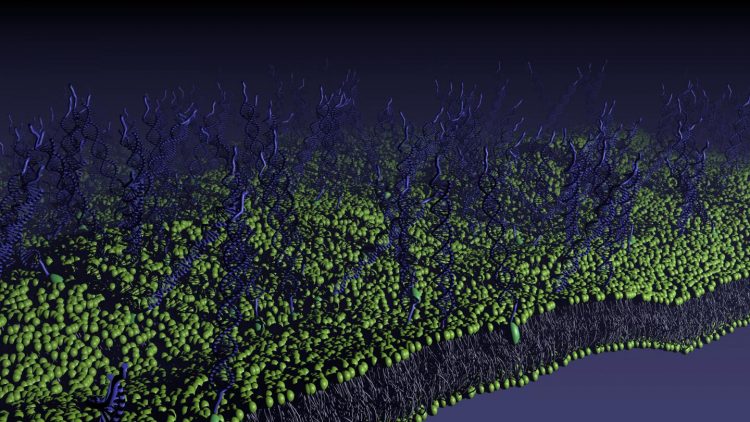Responsive material could be the 'golden ticket' of sensing

This image shows a lipid membrane functionalized with DNA-linkers Credit: Lorenzo Di Michele
The interplay between the lipid spheres, called giant vesicles, and the strands of DNA produces a unique response when the material is exposed to changes in temperature. Instead of expanding when heated – as is normally the case – the material contracts, a phenomenon known as negative thermal expansion. Details are published today (7 January) in the journal Nature Communications.
In addition to its role as a carrier of genetic information, DNA is also useful for building advanced materials. Short strands of DNA, dubbed 'sticky ends', can be customised so that they will only bind to specific complementary sequences. This flexibility allows researchers to use DNA to drive the self-assembly of materials into specific shapes.
Basing self-assembled materials around vesicles – synthetic versions of the soft sacs which envelop living cells – allows for even more flexibility, since the vesicles are so easily deformable. Using short DNA tethers with a cholesterol 'anchor' at one end and an exposed sticky DNA sequence at the other, the vesicles can be stuck together. When assembled into a hybrid DNA-lipid network, the DNA tethers can diffuse and rearrange, resulting in massive vesicle shape changes.
Besides negative thermal expansion, the researchers also found that changes in temperature lead to a significant variation in the porosity of the material, which is therefore highly controllable. A similar response is expected by changing the concentration of the DNA tethers, which could also be replaced by other types of ligand-receptor pairs, such as antibodies.
“The characteristics of this material make it suitable for several different applications, ranging from filtration, to the encapsulation and triggered release of drugs, to biosensors,” said Dr Lorenzo Di Michele of the University's Cavendish Laboratory, who led the research. “Having this kind of control over a material is like a 'golden ticket' of sensing.”
This research is part of the CAPITALS, a UK-wide programme funded by the Engineering and Physical Sciences Research Council (EPSRC). Cambridge Enterprise, the University's commercialisation arm, is currently looking for commercial partners to help develop this material.
Media Contact
More Information:
http://www.cam.ac.ukAll latest news from the category: Materials Sciences
Materials management deals with the research, development, manufacturing and processing of raw and industrial materials. Key aspects here are biological and medical issues, which play an increasingly important role in this field.
innovations-report offers in-depth articles related to the development and application of materials and the structure and properties of new materials.
Newest articles

NASA: Mystery of life’s handedness deepens
The mystery of why life uses molecules with specific orientations has deepened with a NASA-funded discovery that RNA — a key molecule thought to have potentially held the instructions for…

What are the effects of historic lithium mining on water quality?
Study reveals low levels of common contaminants but high levels of other elements in waters associated with an abandoned lithium mine. Lithium ore and mining waste from a historic lithium…

Quantum-inspired design boosts efficiency of heat-to-electricity conversion
Rice engineers take unconventional route to improving thermophotovoltaic systems. Researchers at Rice University have found a new way to improve a key element of thermophotovoltaic (TPV) systems, which convert heat…



